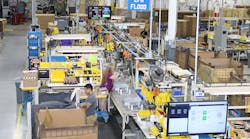All of these subjects will be addressed in the LED Manufacturing track, introduced for the first time at Strategies in Light (SIL) in 2012 (February 7-9, Santa Clara, California). The topic of LED manufacturing was offered as a half-day workshop at Strategies in Light 2011. Due to the sold-out attendance and the overwhelmingly positive response to the workshop, it was decided to devote a full-day conference track to LED manufacturing in 2012. SEMI, the industry trade association, was a key sponsor of the 2011 workshop, and will again be sponsor of the 2012 conference track.
Plenary session
Opening the plenary session will be the featured keynote speaker, Iain Black, VP of Worldwide Manufacturing, Engineering and Innovation at Philips Lumileds Lighting. He will discuss the topic of how the evolving LED market represents a range of challenges for the LED manufacturer. Such challenges include the maturity of processes and equipment, the evolution of product and performance standards, and an immature value chain. See LEDs Magazine’s recent interview with Iain Black for a more detailed review of his presentation.
The second keynote speaker will be Karen Savala, President, Americas with SEMI. Her presentation, entitled “LED Manufacturing Today: Consolidating Expansion and Planning for the Long Haul”, will review LED fab capacity by region and provide estimates of capital spending in the 2012-2013 period. It will also provide an update on global efforts toward industry-wide manufacturing standards.
Another featured speaker in the plenary session will be Jacob Tarn, President of TSMC’s Solid-State Lighting Unit. As the representative of a major silicon-semiconductor manufacturer that is moving into the solid-state lighting space, Tarn will discuss approaches by which such a company can help to accelerate the LED cost-reduction curve and enable LEDs to penetrate the general-purpose lighting market.
Addressing similar issues from the perspective of government-industry collaboration, James Brodrick, SSL Program Manager at the US Department of Energy, will provide a detailed look at the latest edition of DOE’s SSL Manufacturing Roadmap, which examines key cost elements and where future cost reductions will occur.
Wafer-level manufacturing issues
The move to larger substrate sizes - 4-inch and 6-inch - is one approach to help scale up LED production volumes and bring down costs. Raja Parvez, CEO of sapphire producer Rubicon Technology, will give a presentation detailing the manufacturing efficiencies and cost reductions associated with moving to larger-diameter substrates.
There are a number of other ways to improve throughput and productivity during wafer manufacturing. Abdul Lateef, CEO of Plasma-Therm, will discuss the productivity improvements that are possible by adapting front-end plasma processes that have been successfully used for silicon to LEDs. Thomas Uhrmann, Business Development Manager, Compound Semiconductors, for EV Group, will review how high-throughput lithography and metal-wafer bonding can increase LED production efficiency and reduce costs.
Metrology and yield management
In this session, speakers will address the application of metrology to tracking defects during production and using the information obtained as feedback to improving yield. Mike Plisinski, VP and GM of Rudolph Technologies Data Analysis Business, will show how data collected across the entire manufacturing process can be used by process engineers to reduce costs and increase yields.
Dan Scharpf, General Manager of the Systems Business Unit at Labsphere, will discuss how yields can be increased, binning can be more efficient, and the cost of manufacturing can be reduced by moving optical testing further upstream in the manufacturing process.
Packaging
As the final step in the LED manufacturing process, and a key contributor to cost, packaging is receiving increased attention, and advanced techniques and materials are being applied to lower cost and increase performance. Ilkan Cokgor, VP of Global Marketing for Everlight Electronics, will discuss the packaging trends across the LED application space that are helping to drive down the cost per lumen.
Ravi Bhatkal, VP of Energy Technologies at Cookson Electronics, will outline the issues typically encountered in the package-on-board assembly process, and make recommendations for material selection and manufacturing processes that will enable high-reliability luminaire fabrication.
Bringing the packaging session to a close will be Geoff Gardner, Marketing Manager, Lighting, for Dow Corning. His presentation will cover the emerging widespread use of silicones in LED packaging, ranging from direct application on the die to final assembly in a lamp, and the technology challenges facing integration of these materials into LED products.




